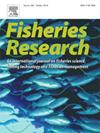Conserving the genetic resources of Rita rita: A GIS-mapping based approach
IF 2.2
2区 农林科学
Q2 FISHERIES
引用次数: 0
Abstract
Understanding the genetic status and spatial distribution of fish species is essential for the conservation and management of their genetic resources. Anthropogenic factors, including hydrological alterations, pollution, overexploitation, deforestation, and the introduction of non-native species, have led to a gradual decline in genetic diversity. In this pioneering study, we investigate the integration of genetic diversity data with spatial statistical tools to map the genetic diversity of wild Rita rita stocks in the River Jhelum, Pakistan. Samples were collected from eight selected sites, and cross-species amplification was conducted using ten microsatellite loci. The Inverse Distance Weighting (IDW) algorithm was applied in ArcGIS 10.2 to generate genetic diversity maps. The study recorded the number of alleles (Na) and allelic richness (Ar) ranging from 3.20 to 4.00, for both Na and Ar. The effective number of alleles (Nae) averaged between 2.459 and 3.506, while observed and expected heterozygosity ranged from 0.640 to 0.724 and 0.526–0.665, respectively. Inbreeding coefficient values varied from −0.077–0.115. A significant departure from Hardy-Weinberg Equilibrium (HWE) was noted in 17 out of 80 tests. Statistically significant FST values demonstrated significant differentiation among population pairs. Analysis of Molecular Variance (AMOVA) indicated that only a small percentage (3.911 %) of the variation existed among stocks. The findings reveal a low level of genetic diversity in the assessed fish stocks, likely attributed to changes in stock dynamics due to climate change and genetic drift resulting from habitat fragmentation. Understanding the genetic structure of R. rita stocks offers valuable insights for genetic improvement programs, effective management practices, and the long-term preservation of riverine genetic resources.
丽塔遗传资源保护:基于gis制图的方法
了解鱼类的遗传状况和空间分布对鱼类遗传资源的保护和管理具有重要意义。人为因素,包括水文变化、污染、过度开发、森林砍伐和外来物种的引入,导致了遗传多样性的逐渐下降。在这项开创性的研究中,我们研究了遗传多样性数据与空间统计工具的整合,以绘制巴基斯坦Jhelum河野生丽塔丽塔种群的遗传多样性。从8个选定的地点采集样本,利用10个微卫星位点进行跨种扩增。在ArcGIS 10.2中应用逆距离加权(IDW)算法生成遗传多样性图谱。Na和Ar的等位基因数和等位基因丰富度分别为3.20 ~ 4.00,有效等位基因数平均为2.459 ~ 3.506,观察杂合度和期望杂合度分别为0.640 ~ 0.724和0.526 ~ 0.665。近交系数变化范围为- 0.077 ~ 0.115。80次测试中有17次明显偏离Hardy-Weinberg平衡(HWE)。统计上显著的FST值表明种群对之间存在显著差异。分子方差分析(AMOVA)表明,种群间的变异比例很小(3.911 %)。研究结果表明,被评估鱼类种群的遗传多样性水平较低,这可能是由于气候变化和栖息地破碎化导致的遗传漂变导致的种群动态变化。了解河豚种群的遗传结构,为河豚遗传改良计划、有效的管理措施和河流遗传资源的长期保存提供了有价值的见解。
本文章由计算机程序翻译,如有差异,请以英文原文为准。
求助全文
约1分钟内获得全文
求助全文
来源期刊

Fisheries Research
农林科学-渔业
CiteScore
4.50
自引率
16.70%
发文量
294
审稿时长
15 weeks
期刊介绍:
This journal provides an international forum for the publication of papers in the areas of fisheries science, fishing technology, fisheries management and relevant socio-economics. The scope covers fisheries in salt, brackish and freshwater systems, and all aspects of associated ecology, environmental aspects of fisheries, and economics. Both theoretical and practical papers are acceptable, including laboratory and field experimental studies relevant to fisheries. Papers on the conservation of exploitable living resources are welcome. Review and Viewpoint articles are also published. As the specified areas inevitably impinge on and interrelate with each other, the approach of the journal is multidisciplinary, and authors are encouraged to emphasise the relevance of their own work to that of other disciplines. The journal is intended for fisheries scientists, biological oceanographers, gear technologists, economists, managers, administrators, policy makers and legislators.
 求助内容:
求助内容: 应助结果提醒方式:
应助结果提醒方式:


